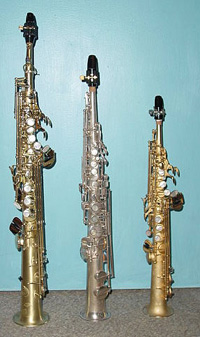C soprano saxophone
This article needs additional citations for verification. (February 2008) |
 B♭ soprano saxophone (left), silver-plated C soprano saxophone (center), E♭ sopranino saxophone (right). | |
| Woodwind instrument | |
|---|---|
| Classification | |
| Hornbostel–Sachs classification | 422.212-71 (Single-reed aerophone with keys) |
| Inventor(s) | Adolphe Sax |
| Developed | 28 June 1846[1] |
| Playing range | |
 In C: sounds as written. | |
| Related instruments | |
|
Military band family:
Orchestral family: Other saxophones:
| |
| Musicians | |
| More articles or information | |
The C soprano saxophone is a member of the saxophone family. It closely resembles the more common B♭ soprano saxophone but is pitched a tone higher. Unlike most other saxophones, it is not a transposing instrument, a quality it shares with the C melody saxophone. The C soprano has a very similar range to the oboe.
In the early 20th century, the C soprano was marketed to those who wished to perform oboe parts in military band, vaudeville arrangements, or church hymnals. C sopranos are the same shape as B♭ sopranos and differ in length by only around 3 centimeters. C soprano saxophones usually have a "C" stamped on them, close to the serial number. The same companies that made C melody instruments manufactured C soprano saxophones (e.g. Conn).[2] As with C melody instruments, production of C sopranos commenced circa 1919 and ended around 1929.
In classical music[]
The C soprano saxophone was used by Richard Strauss in his Sinfonia Domestica, where included in the music are parts for four saxophones including a soprano saxophone in C.
Notes[]
- ^ "June 28, 1846: Parisian Inventor Patents Saxophone". Wired.com. Retrieved 14 February 2011.
- ^ "C Soprano Saxophone Information". Cmelodysax.co.uk. Retrieved 19 May 2014.
- Saxophones
- Woodwind instruments
- C instruments
- Woodwind instrument stubs